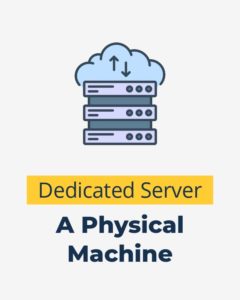If you’re looking to put a website online you will likely have come across two different ways to do it: shared hosting and VPS hosting.
Some companies offer one, some the other, some both. So what’s the difference between shared hosting and VPS hosting?
To put it simply, shared hosting is renting a little bit of file storage in the cloud, and the host company takes care of making sure that those files are on the internet. VPS hosting is renting a whole computer of your own in the cloud, and it’s your job to set that computer up and make it show your website.
It’s like the difference between renting a hotel room and renting an apartment. In a hotel room, you can’t move things around, but the cleaning’s all done for you. In an apartment, you have to clean up yourself but you can have whatever furniture you want. And both are useful; there’s not one that’s better than the other, but they’re suited to different things.
Your job, when deciding between them, is in deciding what’s important to you and what isn’t – whether you’d rather go for simplicity or flexibility.
Here we’ll take a look at the pros and cons of each to help you make that decision.
Table of Contents
- VPS Hosting
- Shared Hosting
- Scaling and Traffic
- Dedicated Servers
- Managed VPS
- Costs
- How to Decide
- In Conclusion
VPS Hosting
 When you buy a VPS what you do is rent a machine; all the software that runs on that machine is your own choice. This gives you a lot of freedom to chop and change that software and to decide what you want to run and how, but it also puts the burden on you to stay up to date with security patches.
When you buy a VPS what you do is rent a machine; all the software that runs on that machine is your own choice. This gives you a lot of freedom to chop and change that software and to decide what you want to run and how, but it also puts the burden on you to stay up to date with security patches.
Security
Running your own VPS requires you to take much more responsibility for the software, and you need to mitigate risks yourself. All software has bugs and security issues, and so new versions of server software are released all the time.
If you’re a WordPress user you’ll be familiar with this. WordPress notifies you when there is an update available and prompts you to install it. In most shared hosting, this is still your responsibility – keeping WordPress up to date is up to you. But in VPS hosting the whole machine’s security is something you need to keep track of, not just WordPress, but also:
- Webserver software (Apache or Nginx)
- MySQL database server
- Underlying operating system
All these things need to be kept up to date, and you need to do that because your VPS hosting provider will not do it for you.
Configuration and Software
The configuration of your VPS software is up to you. This can be a good thing if you’re technically adept since it gives you the ability to tune your website for performance and to adapt how your website runs based on the number of visitors you expect.
But you have to know what needs doing, and you have to know how to do it.
With shared hosting, your hosting provider does all that for you, but you don’t have the option of making changes to it, you get what you’re given. Again, this is a choice for you to make between flexibility and simplicity. If you know what you’re doing then the fixed nature of shared hosting may feel like a straitjacket, but if you aren’t looking to be technically adept then VPS hosting can be bewildering, especially if problems occur.
How much a VPS hosting provider will help you with this can differ wildly between providers, too. From their point of view, they’re responsible for giving you a machine to use, and any problems with that machine itself or the provision of it are things that they will definitely fix.
Problems with software that you installed on the machine, though, are a different story. They’re under no obligation to help you with that. Some VPS providers will still offer assistance or guidance on which software to install and how to configure it. This is something to check when reviewing different providers if you think you’ll need it, and for real support in this, you’ll want to look at managed VPS hosting which we’ll address later.
Shared Hosting
 Shared hosting may sound like a much better option for you if you’re not a technical expert, but it has both pros and cons too which need to be taken into account.
Shared hosting may sound like a much better option for you if you’re not a technical expert, but it has both pros and cons too which need to be taken into account.
Setup and Limitations
As mentioned, the hosting provider takes care of quite a lot of setup for you, but this has the limitation that you’re stuck with the setup that they decide to provide, and you almost always don’t have the option to change this at all. This isn’t just about technical aptitude, most shared hosting providers only allow a certain set of programming languages or environments, and these are rarely at the forefront of technology.
If you’re using WordPress, for example, this is unlikely to be a problem: WordPress is written in PHP and works hard to be backward compatible with older versions of that language. So if the hosting provider is using an older version of PHP then that’s not likely to affect a WordPress installation.
But if you’re using other software that does need newer versions of PHP then you will need to check that the shared hosting you’re looking at does actually provide that newer version. Similarly, shared hosting is often limited to HTML and PHP hosting, which cuts out a fairly large list of web software that uses other languages like node.js, Python, or Ruby. To use software written in these then you’ll almost certainly have to move away from shared hosting entirely and over to a VPS, or an infrastructure-as-a-service provider.
Shared hosting setups are also frequently quite constrained for storage space, or can charge quite heavily for use of storage. This may not be a problem for your website, but if you’re storing a lot of images or multimedia, video, or audio files, then it is important to check how much storage is provided by a shared hosting plan that you’re considering. VPS hosting is normally quite a lot more generous with storage space than shared hosting is (although again this is something that you will want to check.)
Problems and Complications
Shared hosting is also shared, hence the name. What this actually means is that you’re renting a small amount of space on a computer where lots of other companies are also hosting their websites. This isn’t a security problem – different websites that happen to be on the same provider are isolated from one another – but it can mean that the amount of bandwidth and processor time available for your website can be impacted by how busy some other unconnected site is.
If you have the bad luck to be sharing your hosting with another website that suddenly gets popular then this may cause your own site to run more slowly, even though that has nothing to do with you. A higher-end shared hosting provider will detect this situation and compensate for it so that other unconnected sites are not affected, but the cheaper end of the market likely won’t.
This problem is often touted as a serious flaw with shared hosting, which it isn’t. In practice, collisions between websites sharing hosting are rarely actually a problem, but it is still something to bear in mind.
Advantages
One of the advantages of sharing hosting is that the provider can give you add-ons, extra features, and functionality, which are available to you with no work. A shared hosting system might provide:
- Automatic backups
- Visitor logs
- Statistics and analytics
- File manager
- One-click installs for common software
- Email hosting and routing
- Database management
The list is almost endless. All of these features are of course available on VPS hosting if you install different software yourself, but that requires the technical aptitude to do so. With shared hosting, if these things are available, they require no installation or configuration because your provider sets them up for you.
Extra features such as these constitute the majority of what shared hosting providers compete on: one might offer a “bare-bones” service with few or none, while another a “batteries included” service with many extra features bundled as part of your monthly fee.
This is definitely something to consider if you are technical enough to know how to install such things yourself and know which you prefer to install then a VPS host gives you the freedom to have anything you want. If not, then take a look at the features provided by the shared hosts you’re considering to see which you need and which you do not.
Scaling and Traffic
Depending on the amount of traffic you expect for your website, it may also be worth thinking about scalability. If you expect a consistent level of traffic, whether that’s high or low, that doesn’t affect your choices all that much: if you anticipate consistent low traffic then shared hosting will be fine, and consistent high traffic will need you to check bandwidth limits as mentioned for each hosting provider.
But if you expect your traffic to vary – that is, that it will be low sometimes and then occasionally much higher, perhaps for an infrequent special event – then VPS hosts will often allow a temporary boost to your disk space or bandwidth allocation where shared hosting will not. This sort of “bursty” traffic should incline you toward VPS hosting.
The cutoff point for where shared hosting will start to struggle and you’d want to start looking at a more scalable VPS is probably around 30,000 page views per day. These numbers can vary dramatically between different providers, but if you’re expecting to be above that, you’ll probably want to move VPS hosting higher up your priority list.
Dedicated Servers
 A dedicated server is something like VPS hosting but turned up to eleven. A VPS is not actually a whole computer of its own – the letters stand for “Virtual Private Server”, and the keyword in there is virtual. A VPS acts like a complete computer, but it is really only a software computer, called a “virtual machine”.
A dedicated server is something like VPS hosting but turned up to eleven. A VPS is not actually a whole computer of its own – the letters stand for “Virtual Private Server”, and the keyword in there is virtual. A VPS acts like a complete computer, but it is really only a software computer, called a “virtual machine”.
A true server computer may be running many of these virtual machines at once, all isolated from one another. A dedicated server, on the other hand, is a true physical computer, an actual machine, plugged into power and the network, in a rack in someone’s data center.
The distinction between physical machines and virtual machines normally isn’t important, and if it is important to you then you will understand why you might need a dedicated server and why it would be worth it to you to pay the (considerably higher) costs for it. However, you might see hosting companies offering dedicated servers as well as VPS and shared hosting, so this should help you understand what that offer means.
Managed VPS
There is something of a halfway house between the two alternatives: that of managed VPS hosting. This is a setup where you have your own VPS, and therefore have the benefits of your own server (flexibility, the chance to run any software you choose, greater capacity) but where the hosting company manages that VPS for you, so they’re the system administrator and you aren’t. This might seem like the best of both worlds, and it is for people who don’t want to or can’t manage a server themselves. However, there is of course a downside to it: cost.
Managed VPS hosting is considerably more expensive than unmanaged (or “self-managed”) VPS hosting, and that’s something you’d need to consider. If you have software requirements that need you to use a VPS, and you don’t have system administrators on staff, then a fully managed VPS may be the way to go. It is essentially like hiring the hosting provider as a system administrator, with the costs that go along with that.
Costs
It is useful to look at costs, at this point. We also have a comprehensive list of best web hosting and VPS hosting providers already, but a summary may give you some idea of where hosting fits into your website budget and roughly what the range of prices you can expect are.
Here we list some popular providers in each category with some indication of their monthly costs. No special offers or bulk-purchase prices are included here, in order to give you a comparison of the base-level outlay on each.
When you investigate providers, consider their bulk pricing deals, which can be substantially cheaper. These costs are also for the most basic plans and the smallest VPSes and bandwidth allocations. If your VPS needs more disk space, more bandwidth, or more CPU power then these costs can significantly increase.
Many hosting companies offer both shared hosting and VPS hosting plans, and some even both unmanaged and managed VPS hosting.
| Provider | Hosting type | Cost per month |
|---|---|---|
| Dreamhost | Managed VPS | $10.00-$80.00 |
| Shared | $2.59-$3.95 | |
| Hostinger | Unmanaged VPS | $3.95-$29.95 |
| Shared | $0.99-$3.99 | |
| InMotion | Managed VPS | $17.99-$72.99 |
| Unmanaged VPS | $5.00-$160.00 | |
| Shared | $2.49-$12.99 | |
| Bluehost | Unmanaged VPS | $18.99-$59.99 |
| Shared | $2.75-$13.95 | |
| Hostgator | Managed VPS | $19.95-$39.95 |
| Shared | $2.75-$5.95 |
How to Decide
 Now that you’ve seen the various aspects that play into your decision to go with shared hosting or VPS hosting, here’s the summary of things to consider. These aren’t necessarily requirements that make the decision for you, but they are a checklist to help you narrow down on a provider you want, running a service that gives you whatever you need.
Now that you’ve seen the various aspects that play into your decision to go with shared hosting or VPS hosting, here’s the summary of things to consider. These aren’t necessarily requirements that make the decision for you, but they are a checklist to help you narrow down on a provider you want, running a service that gives you whatever you need.
- Technical aptitude. If you are not willing to take on the responsibility of being a system administrator, or if you don’t need the flexibility of a VPS, then you’re advised to strongly consider shared hosting or fully managed VPS hosting. Staying on top of security updates and configurations can be difficult and involve hard work. If you don’t have a good reason to want to do this, and if your website applications can work on shared hosting, then consider shared hosting so that the responsibilities of security are handled by your hosting provider.
- Storage space and bandwidth. If your site stores a lot of data or is expected to be busy (either all the time or at peak times) then you need to consider any caps on storage or bandwidth from the providers you look at. VPS hosting is likely to be able to scale larger if you need it. If you anticipate a brief period where your site will attract a lot more attention than normal, then a VPS provider is likely to provide a way to temporarily add more capacity to cope with this burst, and this should help inform your decision.
- Extra features. It is always a good policy to have good backups of your site in place, as well as access to server logs and analytics beyond what Google Analytics offers. If you’re using VPS hosting then these additional features are on your shoulders to install and configure. Shared hosting may give you the things you need without setup or configuration required. Consider what you’re looking for and what a provider offers when making your decision.
- Cost. VPS hosting is generally more expensive, both in individual monthly cost and in your time required to manage it. If you don’t need what it provides, you can save money by going shared.
- Software. If your software is in PHP, and in particular if it’s WordPress, you will likely not need a VPS. Shared hosting will probably be sufficient, easier to use, and cheaper. If your software requirements are more complex, then check what your choice of shared host can support – you are quite likely to need to build your own hosting environment, which means a VPS.
You should also bear in mind that this decision is not necessarily permanent. If your website has good backups, then moving it from one provider to another should be relatively easy. Moving from shared hosting to VPS hosting with the same provider should be easier still. Be aware of the need for good backups from the beginning, and then you are not greatly constrained to a particular type of hosting. If it turns out that shared hosting can’t cope with the visitor count you get, you can always migrate to VPS hosting later if you need to.
In Conclusion
If you require flexibility or complicated software and you have the technical ability to use it, choose VPS hosting. If you don’t need the flexibility or you don’t have the technical skills to use it, then shared hosting will likely be fine.
If you really do need VPS hosting but don’t have the skills in-house, consider fully managed VPS hosting, or recruiting in-house staff or an external agency to manage your website deployments for you.
0 comments